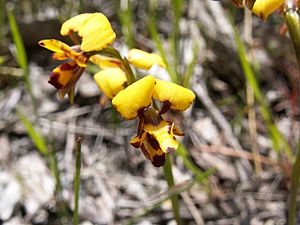Bee orchid facts for kids
Quick facts for kids Bee orchid |
|
|---|---|
 |
|
| D. laxiflora growing in Cranbrook, Western Australia. | |
| Scientific classification | |
| Genus: |
Diuris
|
| Species: |
laxiflora
|
The Bee Orchid, also known as the Banded Bee Orchid (its scientific name is Diuris laxiflora), is a special type of orchid. It grows only in Western Australia, which means it's endemic there. This small orchid is quite common in the areas where it lives. It's about half the size of another well-known orchid called the Donkey Orchid.
What Does the Bee Orchid Look Like?
The Bee Orchid is a perennial herb, which means it's a plant that lives for more than two years and doesn't have a woody stem. It grows from a tuber (a swollen underground stem, like a potato).
Each plant has 4 to 6 leaves that grow in a clump. These leaves are usually 60 to 150 millimeters long and 2 to 3 millimeters wide. The flower stem can grow quite tall, from 300 to 500 millimeters. On each stem, you'll find 1 to 6 flowers.
These flowers are about 10 to 13 millimeters across. They are bright yellow with interesting brown spots. You can usually see them blooming from August to October.
How Did It Get Its Name?
The Bee Orchid was first officially described by a botanist named John Lindley in 1839. He wrote about it in his book, "A Sketch of the Vegetation of the Swan River Colony".
The scientific name laxiflora comes from two Latin words. Laxus means 'wide', 'loose', or 'open', and floris means 'flower'. So, laxiflora refers to how the flowers are openly arranged on the stem.
Where Do Bee Orchids Grow?
This special orchid only grows in the southwestern part of Western Australia. You can find it in several different natural areas, including the Avon Wheatbelt, Esperance, Geraldton Sandplains, Jarrah Forest, Mallee, Swan Coastal Plain, and Warren regions.
It likes to grow in different types of soil, such as sand, clay, and a type of soil called lateritic loam. You might also find it near granite rocks. It especially likes areas that are wet during the winter, like swamps.

